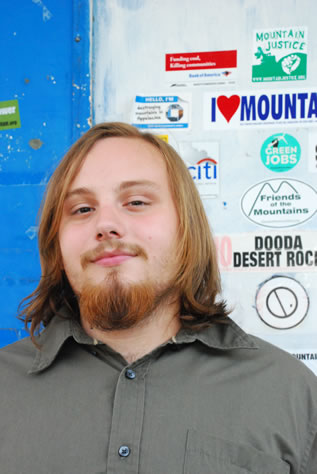
I was born and raised in Southern West Virginia, a place where not a lot of people identify themselves as environmentalists. So I get called a “tree hugger” all the time. But I don’t mind. If trying to keep my neighbors from dying of cancer makes me a tree hugger – well, then, I’m a tree hugger.
Appalachia is the second most biodiverse area in the entire world, second only to the Amazon rainforest. Southern West Virginia – there’s just something different, and special, about this place. I don’t feel at home anywhere else.
But it’s also a place that’s plagued with a lot of problems – and the worst is mountaintop removal (MTR) coal mining. When the coal companies started the strip mining and the mountaintop removal, it was hell for some people. The dust and the poisoned water that come off those sites are horrible, and are impacting people all over West Virginia. The crazy thing is, even many of us who have lived here all our lives ignore the problems unless something really opens our eyes to them.
After high school, I did what everyone else does in my area when you don’t have enough money to go to college: I went to work for the coal company Massey Energy. My dad helped get me a job at the Elk Run Coal Prep Plant, which is just a few miles from my house, and where he still works today.
Some days they had me picking up machinery that was broken down, or walking the belt lines to make sure nothing was caught in there. Some days they put me in the basement of the plant, standing waist-deep in coal sludge and spraying down the walls with a pressure hose. No goggles or respirator or anything, just a pair of fishing waders.
I could only take about six months of that work, and then I quit. I floated around from job to job and then, in late 2009, a friend of the family offered me a job as a security guard on a mountaintop removal site. I jumped right on it. Sitting on your butt for 12 hours a day and getting paid for it – I was all over that!
When I got up there the first day and looked out at the mine, it completely blew my mind. At that point I had never seen a strip mine. Even when I was working at the prep plant I never walked up the road to see where they were getting the coal from. So when I saw it, I was shocked. They had taken beautiful places – places that I knew and loved – and turned them into wastelands.
Looking out at the mine, I thought: Why are we doing this to ourselves? And I knew that those people who lived below that mountain were going through the same things that I was going through when I was growing up beneath a mountaintop removal site. And I felt like the most terrible human being in the world for making a profit out of what those people were going through.
Around the time I was working as a mine guard, I started volunteering for a group called Coal River Mountain Watch, which tries to stop MTR. In just a short time, the late, great Judy Bonds, who was a real mentor to me, offered me a job at Coal River Mountain Watch. Suddenly I had this big choice in front of me. Either I could go work in some coal mine somewhere and keep the respect of my family and community. Or, I could go to work for Coal River Mountain Watch, and try to stop the abuses of MTR, and completely be shunned by a good portion of my community and my family.
I decided to start working for Coal River Mountain Watch. I was kicked out of my parents’ house because, if I kept living under their roof, my dad would have lost his job. And that to me is one of the worst impacts the coal industry has on Southern West Virginia. It’s not just the economic grasp it has on the place, but also the mental grasp it has on the people. That is one of the most horrible ways that the coal industry is ruining the beauty of Appalachia.
We don’t have a paywall because, as a nonprofit publication, our mission is to inform, educate and inspire action to protect our living world. Which is why we rely on readers like you for support. If you believe in the work we do, please consider making a tax-deductible year-end donation to our Green Journalism Fund.
DonateGet four issues of the magazine at the discounted rate of $20.